Citroen C3 2015 2.G Workshop Manual
Manufacturer: CITROEN, Model Year: 2015, Model line: C3, Model: Citroen C3 2015 2.GPages: 401, PDF Size: 13.04 MB
Page 51 of 401
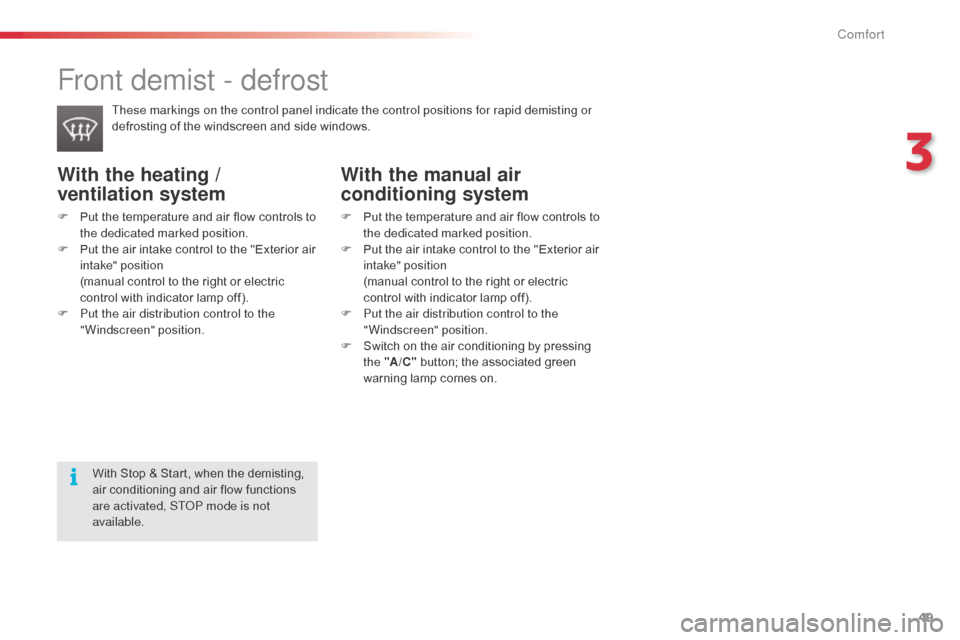
49
With the heating /
ventilation system
F Put the temperature and air flow controls to the dedicated marked position.
F
P
ut the air intake control to the "Exterior air
intake" position
(
manual control to the right or electric
control with indicator lamp off).
F
P
ut the air distribution control to the
"Windscreen" position.
Front demist - defrost
These markings on the control panel indicate the control positions for rapid demisting or
defrosting of the windscreen and side windows.
With the manual air
conditioning system
F Put the temperature and air flow controls to the dedicated marked position.
F
P
ut the air intake control to the "Exterior air
intake" position
(
manual control to the right or electric
control with indicator lamp off).
F
P
ut the air distribution control to the
"Windscreen" position.
F
S
witch on the air conditioning by pressing
the "A /C " button; the associated green
warning lamp comes on.
With Stop & Start, when the demisting,
air conditioning and air flow functions
are activated, ST
oP m
ode is not
available.
3
Comfort
Page 52 of 401
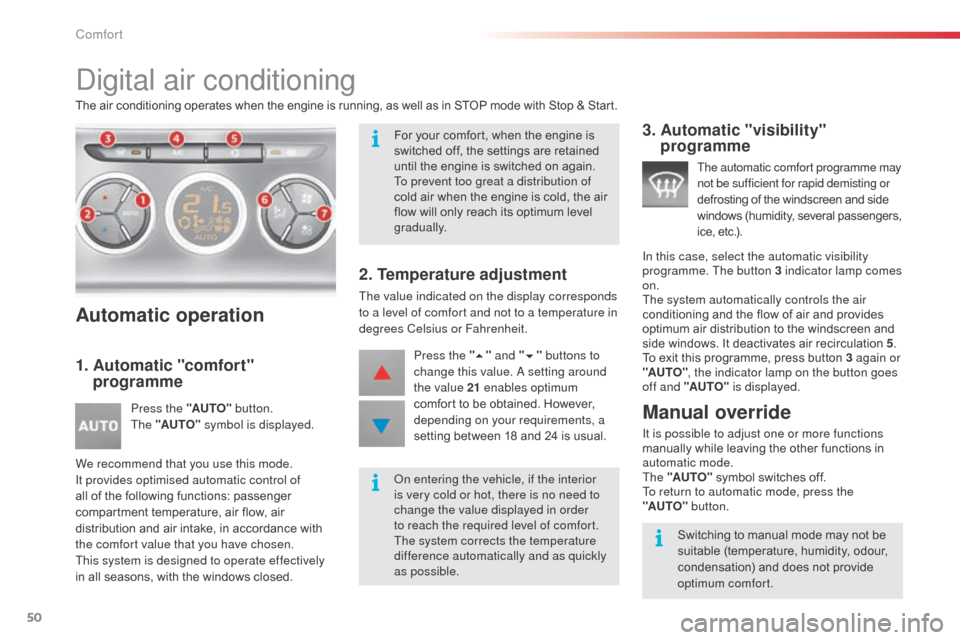
50
digital air conditioning
The air conditioning operates when the engine is running, as well as in STOP mode with Stop & Start.
Automatic operation
1. Automatic "comfort" programme
Press the "AUTO" button.
The "AUTO" symbol is displayed.
We recommend that you use this mode.
It provides optimised automatic control of
all of the following functions: passenger
compartment temperature, air flow, air
distribution and air intake, in accordance with
the comfort value that you have chosen.
This system is designed to operate effectively
in all seasons, with the windows closed.
2. Temperature adjustment
The value indicated on the display corresponds
to a level of comfort and not to a temperature in
degrees Celsius or Fahrenheit. Press the " 5" and " 6" buttons to
change this value.
a setting around
the value 21 enables optimum
comfort to be obtained. However,
depending on your requirements, a
setting between 18 and 24 is usual.
3. Automatic "visibility" programme
The automatic comfort programme may
not be sufficient for rapid demisting or
defrosting of the windscreen and side
windows (humidity, several passengers,
ice, etc.).
In this case, select the automatic visibility
programme. The button 3 indicator lamp comes
on.
The system automatically controls the air
conditioning and the flow of air and provides
optimum air distribution to the windscreen and
side windows. It deactivates air recirculation 5 .
To exit this programme, press button 3 again or
"AUTO" , the indicator lamp on the button goes
off and "AUTO" is displayed.
Manual override
It is possible to adjust one or more functions
manually while leaving the other functions in
automatic mode.
The "AUTO" symbol switches off.
To return to automatic mode, press the
"AUTO"
button.
For your comfort, when the engine is
switched off, the settings are retained
until the engine is switched on again.
To prevent too great a distribution of
cold air when the engine is cold, the air
flow will only reach its optimum level
gradually.
on e
ntering the vehicle, if the interior
is very cold or hot, there is no need to
change the value displayed in order
to reach the required level of comfort.
The system corrects the temperature
difference automatically and as quickly
as possible. Switching to manual mode may not be
suitable (temperature, humidity, odour,
condensation) and does not provide
optimum comfort.
Comfort
Page 53 of 401
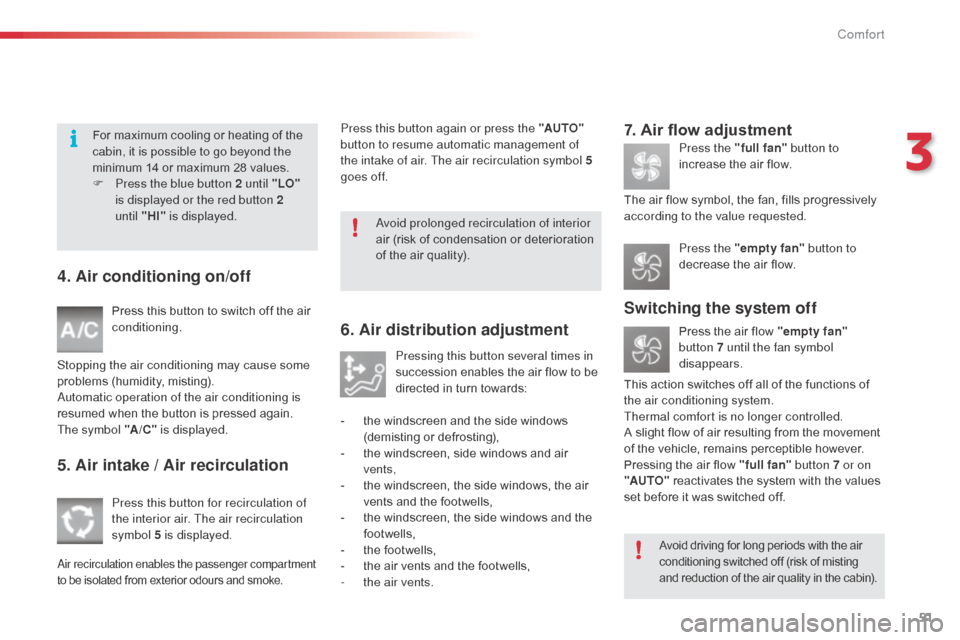
51
4. Air conditioning on/off
Press this button to switch off the air
conditioning.
Stopping the air conditioning may cause some
problems (humidity, misting).
au
tomatic operation of the air conditioning is
resumed when the button is pressed again.
The
symbol "A /C " is displayed.
5. Air intake / Air recirculation
Press this button for recirculation of
the interior air. The air recirculation
symbol 5 is displayed.
air recirculation enables the passenger compartment
to be isolated from exterior odours and smoke.
6. Air distribution adjustment
Pressing this button several times in
succession enables the air flow to be
directed in turn towards:
-
t
he windscreen and the side windows
(demisting or defrosting),
-
t
he windscreen, side windows and air
vents,
-
t
he windscreen, the side windows, the air
vents and the footwells,
-
t
he windscreen, the side windows and the
footwells,
-
t
he footwells,
-
t
he air vents and the footwells,
-
t
he air vents.
7. Air flow adjustment
Press the "full fan" button to
increase the air flow.
The air flow symbol, the fan, fills progressively
according to the value requested.
Switching the system off
Press the air flow "empty fan"
button 7 until the fan symbol
disappears.
This action switches off all of the functions of
the air conditioning system.
Thermal comfort is no longer controlled.
A
slight flow of air resulting from the movement
of the vehicle, remains perceptible however.
Pressing the air flow "full fan" button 7 or on
"AUTO" reactivates the system with the values
set before it was switched off. Press the "empty fan"
button to
decrease the air flow.
Press this button again or press the "AUTO"
button to resume automatic management of
the intake of air. The air recirculation symbol 5
goes off.
Avoid driving for long periods with the air
conditioning switched off (risk of misting
and reduction of the air quality in the cabin).
For maximum cooling or heating of the
cabin, it is possible to go beyond the
minimum 14 or maximum 28 values.
F
P
ress the blue button 2 until "LO"
is displayed or the red button 2
until
"HI" is displayed.
av
oid prolonged recirculation of interior
air (risk of condensation or deterioration
of the air quality).
3
Comfort
Page 54 of 401

52
Rear screen demist - defrost
Switching on
The rear screen demisting/defrosting can only
operate when the engine is running.
F
P
ress this button to demist /defrost the
rear screen and (depending on version)
the door mirrors. The indicator lamp
associated with the button comes on.
Switching off
The demisting/defrosting switches off
automatically to prevent an excessive
consumption of current.
F
I
t is possible to stop the demisting/
defrosting operation before it is switched
off automatically by pressing the button
again. The indicator lamp associated with
the button switches off.
The control button is located on the heating or air conditioning system control panel.
Switch off the demisting/defrosting
of the rear screen and door mirrors
as soon as appropriate, as reducing
electrical power consumption results in
reduced fuel consumption.
With Stop & Start, when demisting has
been activated, the ST
oP m
ode is not
available.
If the engine is switched off before the
demisting/defrosting is switched off
automatically, demisting/defrosting will
resume next time the engine is switched on.
Comfort
Page 55 of 401
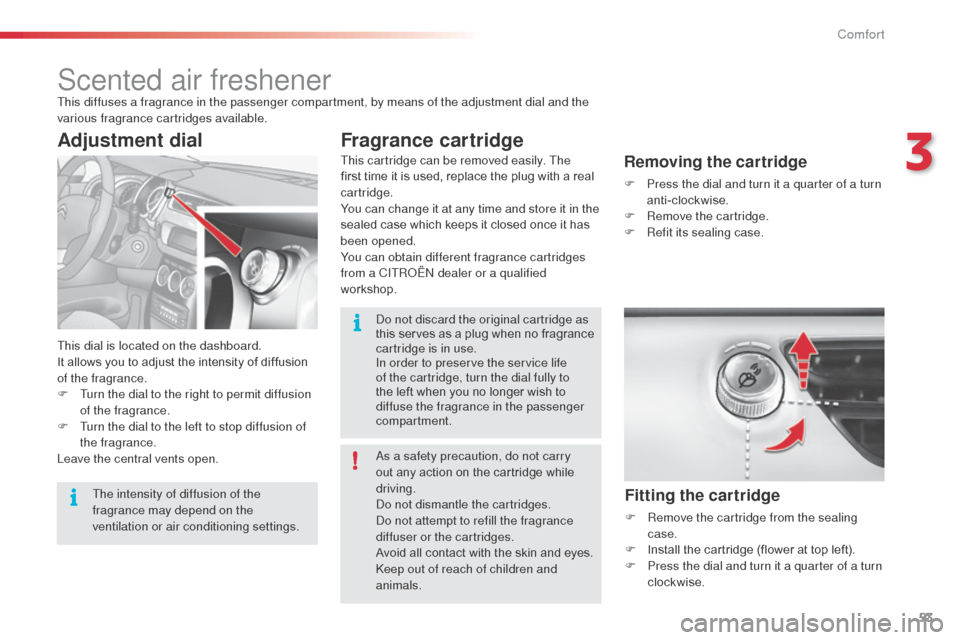
53
Scented air freshenerThis diffuses a fragrance in the passenger compartment, by means of the adjustment dial and the
various fragrance cartridges available.
This dial is located on the dashboard.
It allows you to adjust the intensity of diffusion
of the fragrance.
F
T
urn the dial to the right to permit diffusion
of the fragrance.
F
T
urn the dial to the left to stop diffusion of
the fragrance.
Leave the central vents open.
Fragrance cartridge
Removing the cartridge
F Press the dial and turn it a quarter of a turn anti-clockwise.
F
R
emove the cartridge.
F
R
efit its sealing case.
Fitting the cartridge
F Remove the cartridge from the sealing case.
F
I
nstall the cartridge (flower at top left).
F
P
ress the dial and turn it a quarter of a turn
clockwise.
as a s
afety precaution, do not carry
out any action on the cartridge while
driving.do n
ot dismantle the cartridges.do n
ot attempt to refill the fragrance
diffuser or the cartridges.
Avoid all contact with the skin and eyes.
ke
ep out of reach of children and
animals.
do n
ot discard the original cartridge as
this serves as a plug when no fragrance
cartridge is in use.
In order to preserve the service life
of the cartridge, turn the dial fully to
the left when you no longer wish to
diffuse the fragrance in the passenger
compartment.
The intensity of diffusion of the
fragrance may depend on the
ventilation or air conditioning settings.
Adjustment dial
This cartridge can be removed easily. The
first time it is used, replace the plug with a real
cartridge.
You can change it at any time and store it in the
sealed case which keeps it closed once it has
been opened.
You can obtain different fragrance cartridges
from a CITR
oËn
dealer or a qualified
workshop.
3
Comfort
Page 56 of 401

54
Front seatsSeat consisting of a seat cushion, a seat back and a head restraint which can all be adjusted to
adapt your position for ease of driving and comfort.
F
Ra
ise the control and slide the seat
for wards or backwards. F
P
ull the control upwards to raise or push
it downwards to lower, as many times as
required, to obtain the position required.
Forwards-backwards Height
F Push the control rear wards.
Seat backrest angle
Adjustments
Before moving the seat backwards, ensure that there is nothing that might prevent the full travel of the seat, so as to avoid the risk of of jamming
the seat caused by the presence of objects on the floor behind the seat or rear passengers. If the seat jams, stop the movement immediately.
Comfort
Page 57 of 401
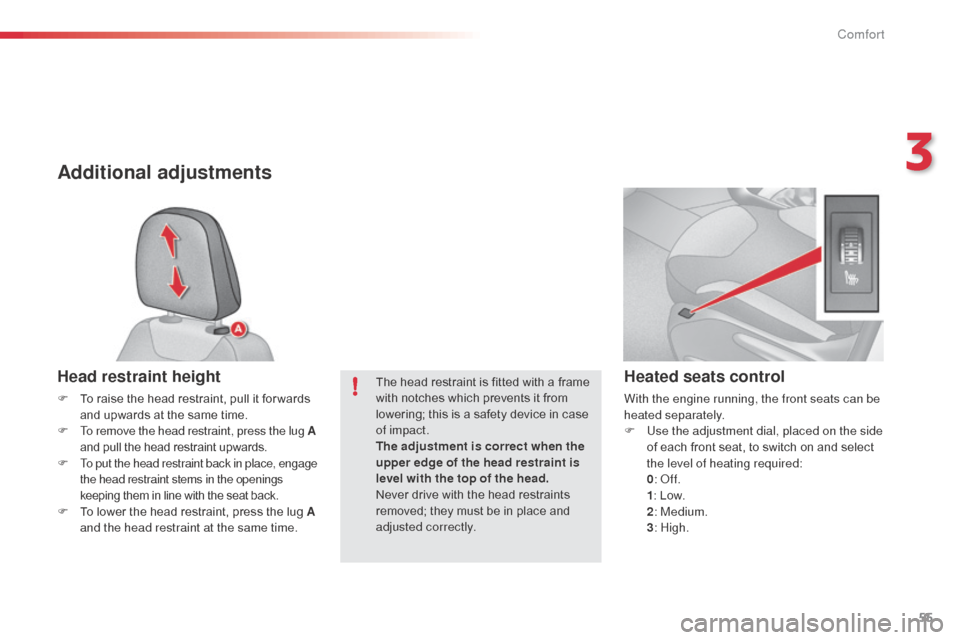
55
Additional adjustments
Head restraint height
F To raise the head restraint, pull it for wards and upwards at the same time.
F
T
o remove the head restraint, press the lug A
and pull the head restraint upwards.
F
To put the head restraint back in place, engage
the head restraint stems in the openings
keeping them in line with the seat back.
F To lower the head restraint, press the lug A and the head restraint at the same time.
Heated seats control
With the engine running, the front seats can be
heated separately.
F
U
se the adjustment dial, placed on the side
of each front seat, to switch on and select
the level of heating required:
0 :
o
f
f.
1: L
ow.
2: M
edium.
3:
High.
The head restraint is fitted with a frame
with notches which prevents it from
lowering; this is a safety device in case
of impact.
The adjustment is correct when the
upper edge of the head restraint is
level with the top of the head.
Never drive with the head restraints
removed; they must be in place and
adjusted correctly.
3
Comfort
Page 58 of 401
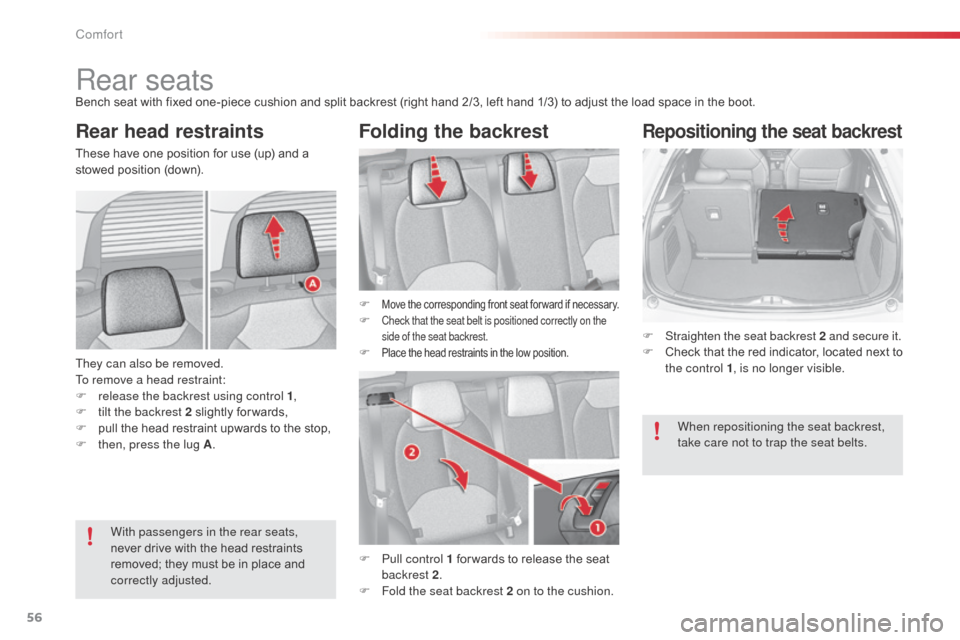
56
Rear seatsBench seat with fixed one-piece cushion and split backrest (right hand 2/3, left hand 1/3) to adjust the load space in the boot.
Rear head restraintsFolding the backrest
They can also be removed.
To remove a head restraint:
F
r
elease the backrest using control 1 ,
F
t
ilt the backrest 2 slightly for wards,
F
p
ull the head restraint upwards to the stop,
F
t
hen, press the lug A . F
Move the corresponding front seat for ward if necessary.F Check that the seat belt is positioned correctly on the
side of the seat backrest.
F Place the head restraints in the low position.
With passengers in the rear seats,
never drive with the head restraints
removed; they must be in place and
correctly adjusted.
These have one position for use (up) and a
stowed position (down).
F
P
ull control 1 for wards to release the seat
backrest 2 .
F
F
old the seat backrest 2 on to the cushion.
Repositioning the seat backrest
When repositioning the seat backrest,
take care not to trap the seat belts.
F
S
traighten the seat backrest 2
and secure it.
F
C
heck that the red indicator, located next to
the control 1 , is no longer visible.
Comfort
Page 59 of 401
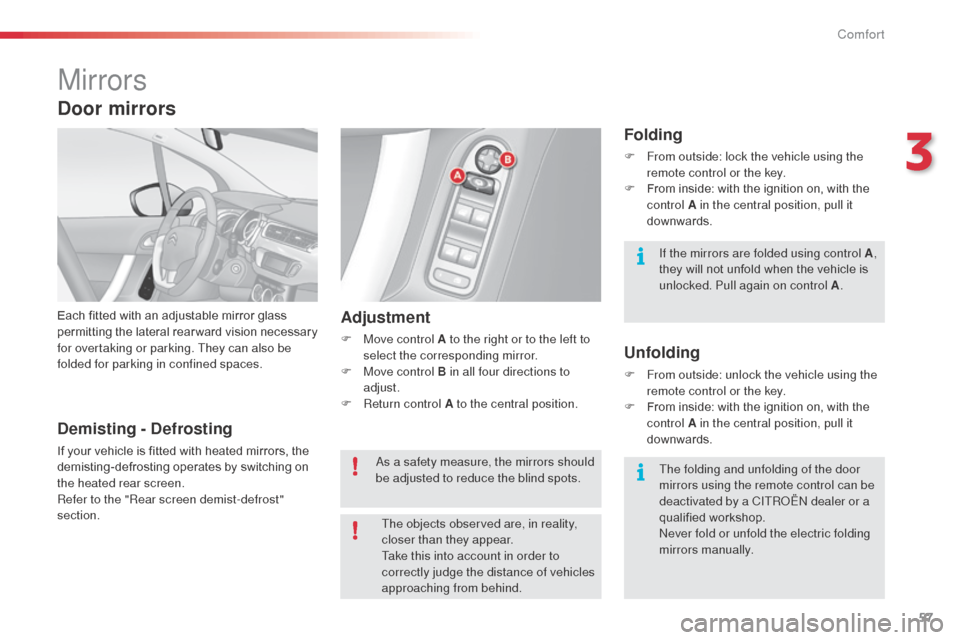
57
Mirrors
Each fitted with an adjustable mirror glass
permitting the lateral rearward vision necessary
for overtaking or parking. They can also be
folded for parking in confined spaces.Adjustment
F Move control A to the right or to the left to select the corresponding mirror.
F
M
ove control B in all four directions to
adjust.
F
R
eturn control A to the central position.
Folding
F From outside: lock the vehicle using the remote control or the key.
F
F
rom inside: with the ignition on, with the
control A in the central position, pull it
downwards.
Unfolding
F From outside: unlock the vehicle using the remote control or the key.
F
F
rom inside: with the ignition on, with the
control A in the central position, pull it
downwards.
Demisting - Defrosting
If your vehicle is fitted with heated mirrors, the
demisting-defrosting operates by switching on
the heated rear screen.
Refer to the "Rear screen demist-defrost"
section.
Door mirrors
as a safety measure, the mirrors should
be adjusted to reduce the blind spots. If the mirrors are folded using control A
,
they will not unfold when the vehicle is
unlocked. Pull again on control A .
The folding and unfolding of the door
mirrors using the remote control can be
deactivated by a CITR
oËn
dealer or a
qualified workshop.
ne
ver fold or unfold the electric folding
mirrors manually.
The objects observed are, in reality,
closer than they appear.
Take this into account in order to
correctly judge the distance of vehicles
approaching from behind.
3
Comfort
Page 60 of 401
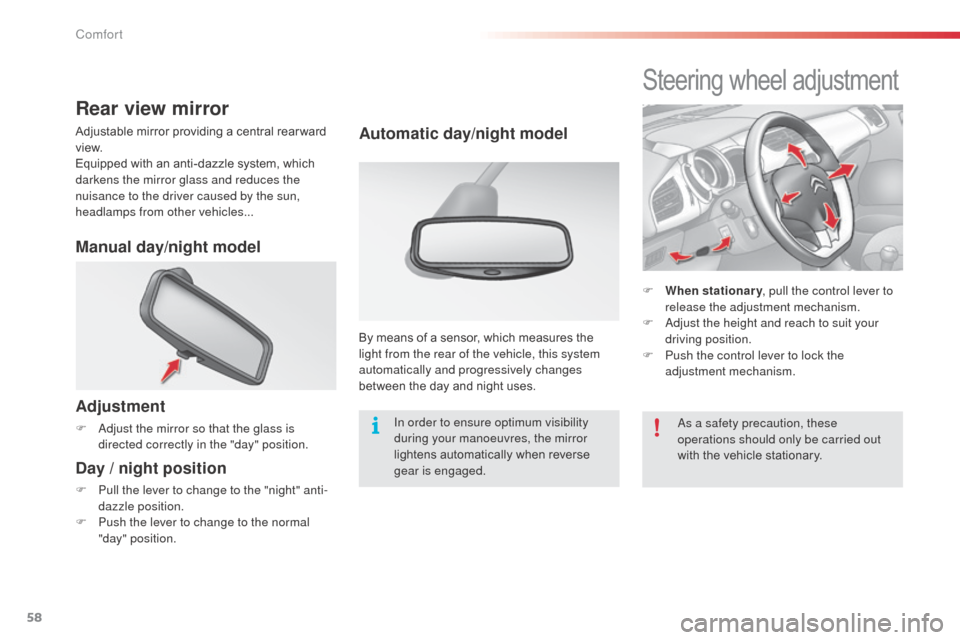
58
Steering wheel adjustment
F When stationary, pull the control lever to
release the adjustment mechanism.
F
a
d
just the height and reach to suit your
driving position.
F
P
ush the control lever to lock the
adjustment mechanism.
Rear view mirror
Adjustable mirror providing a central rear ward
view.
Equipped with an anti-dazzle system, which
darkens the mirror glass and reduces the
nuisance to the driver caused by the sun,
headlamps from other vehicles...
Adjustment
F adjust the mirror so that the glass is directed correctly in the "day" position.
Day / night position
F Pull the lever to change to the "night" anti-dazzle position.
F
P
ush the lever to change to the normal
"day" position.
Automatic day/night model
By means of a sensor, which measures the
light from the rear of the vehicle, this system
automatically and progressively changes
between the day and night uses.
Manual day/night model
In order to ensure optimum visibility
during your manoeuvres, the mirror
lightens automatically when reverse
gear is engaged.as a s afety precaution, these
operations should only be carried out
with the vehicle stationary.
Comfort